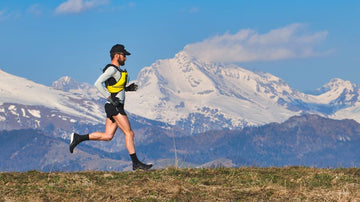Altitude training is a variant of physical preparation that is gaining more and more integers. The dynamic consists of preparing the preparatory routines for tests in high-altitude locations , to get the most out of oxygen consumption.
Athletics, cycling, triathlon, swimming , and even cross-country skiing and mountaineering , the latter for obvious reasons, are sports in which this practice is very popular. We tell you in detail what are the benefits of training at altitude and how to prepare for it.
What does altitude training consist of?
High altitude training involves designing long training sessions, not the sessions themselves, but the time spent under these conditions, at altitudes that can range between 1,800 and 2,500 meters , although in some cases that lower limit descend to 1200 meters
A stage or a correct preparation of this type of training implies spending at least four or five continuous weeks . Many athletes approach these sessions as part of their preseason.
The idea with training at altitude is to reach contexts of hypoxia, that is, low oxygen concentration . In this way, if you are able to perform in those circumstances, when you compete at lower altitudes, the sporting results improve.
The idea of training at altitude is something very common in high competition sport, especially in some modalities, since it has been shown that people who were born and live at a sufficient altitude, above the mentioned values, have higher blood values than those of people who live in areas at sea level or a few hundred meters above sea level.
The positive aspect of adapting the body to these high altitudes is that it is possible to improve oxygen transport and the maximum consumption of this cellular nutrient, something that is closely linked to long-distance and endurance sports.
What sports are trained at altitude
Virtually all sports can be trained at high altitudes, but it is true that this variant is more designed for long-distance and endurance modalities . In cycling , for example, it is common for many athletes to have their residence fixed in mountainous areas such as the Alps, the Pyrenees or to hold concentrations in Tenerife, in the surroundings of Teide.
In turn, the cycling tradition of countries such as Colombia and Ecuador is known, especially climbers, due to the high altitudes of some areas of those countries. In runners , triathletes, ultratrail athletes and other athletes who practice high resistance modalities, this type of training is also common.
It should be noted that training at altitude for athletics affects the body in various ways. The higher the altitude, the lower the density and atmospheric pressure , which translates into a partial decrease in oxygen and an increase in ventilation. The feeling when training at altitude is that you are short of breath.
Factors that influence training at altitude
The negative effects of high altitude are corrected by the organism, once it acclimatizes to the new conditions, through the increase in the production of the endogenous erythropoietin hormone, EPO.
This substance, which can be a reason for doping if certain limits are exceeded, is secreted naturally by the kidney to produce more red blood cells and with them transport more oxygen to the muscles.
When training at altitude it is important to overcome phases. The first is acclimatization , which takes four or five days and allows the body time to get used to a situation of increased oxygen demand. After this step comes the design of the training sessions, which must be very progressive , with a lower physical demand at the beginning that is amplified as the days go by.
When staying at altitude lasts a few days, the body gradually adapts its physiology to these new conditions . The concentration of oxygen in the atmosphere does not change, but the partial pressure does. Thus, a part of that acclimatization is the reduction in cardiac output both at rest and during exercise and an increased production of red blood cells , which is closely related to EPO.
Maximal oxygen consumption improves during altitude training, as does growth hormone synthesis. The level of altitude necessary for these improvements in performance to occur depends to a large extent on the intrinsic conditions of each organism, since, for those athletes who demonstrate more resistance to the production of red blood cells, it will be necessary to ascend to higher levels. tall.
In general, athletes who train at altitude do so between 1,500 and 2,500 meters of altitude and spend seasons ranging from one week to longer periods, even a month and a half.
Risks of training at height
High altitude training is often talked about as an ideal formula to improve physical performance in endurance sports, but there are associated risks that are also worth knowing about.
First, if you are exposed to low oxygen pressure conditions for a long time, which can lead to increased red blood cell proliferation, you also end up with thicker blood and long-term cardiovascular problems .
Also, above 2000 meters hypoxia can play tricks. Altitude sickness, which is something that many mountaineers suffer frequently, is the inability to get oxygen to the nervous system, something that can cause irreversible problems in the brain.
Altitude sickness is not a process that appears immediately, rather they are gradual symptoms. In the first place, a feeling of euphoria is experienced and the risks are minimized, but, after a while, the muscles become numb and the body begins to feel heavy , a generalized fatigue that can make you lose consciousness.
The risks of training at altitude can also appear once you return to low altitude, in the readaptation phase. These are not serious problems, but rather behaviors that are acclimating to the new conditions: respiratory irregularity and a feeling of fatigue on exertion. These effects can become evident between one and four weeks after having descended.
Benefits of training at altitude
Let's use running to talk about the benefits of training at altitude to prepare for sports events. This mode of work, according to an experiment carried out by Levine and Stray Gundersen , the first authors to demonstrate this effect in 1997, in consistent improvements among those who live at high altitudes and train at lower elevations.
These authors planned three groups of collegiate-level endurance athletes. One group always lived and trained at altitude, 2,500 meters above sea level. The second lived at that same elevation, but trained at 1,200 meters. And finally the third lived and trained at 1200 meters. The results obtained showed a clear improvement in the group that lived at 2,500 mere and trained at 1,200 meters, with a 13-second improvement in 5,000-meter races.
Subsequently, studies have been carried out that have influenced the benefits of training at altitude that have resulted in improvements in basic resistance, resistance to force , in the behavior of skeletal muscles, a greater tolerance to fatigue and also greater recovery in periods of competition.
What can help you train at altitude
Beyond acclimatization to the altitude, a key aspect to perform in these circumstances is to plan your training and diet well . The consumption of carbohydrates is essential because they are the main source of energy during exercise.
Thus, when you train at altitude, carbohydrate consumption increases . Many experts talk about combining diets rich in carbohydrates with nutritional supplements that are also high in these nutrients.
Going to products like Waxy Maize , from Scenit Nutrition, which ensure the release of complex carbohydrates to provide immediate energy, is key to overcoming training at altitude.
The consumption of carbohydrates helps to delay glycogen depletion , that is, the decrease in this polysaccharide in the blood. This improves performance, or at least mitigates performance loss.
In turn, it is advisable to go to good hydrators, because by increasing iron and antioxidant requirements due to hypoxic conditions, the body loses many electrolytes. With Best Isotonic those lost ions are recovered effectively. These hydrators are also very suitable in conditions of intense exercise at high temperatures.
One last supplementation proposal, and always as a complement to diet and rest, is to resort to branched chain amino acids, since again hypoxia implies extra, very intense physical effort. BCAAs have a restorative effect on muscle fibers.
High altitude training has been shown to be very useful for athletes and athletes who practice resistance tests. Its implementation implies good planning to make the most of the atmospheric, pressure and altitude conditions and at the same time minimize the associated risks.





